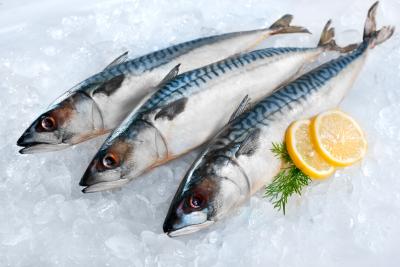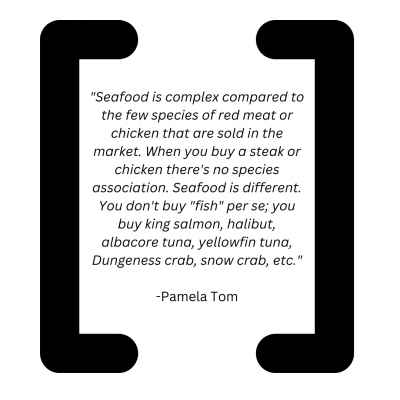Pamela Tom was an academic coordinator and seafood specialist for California Sea Grant between 1983 and 2013, and spent most of her career based at UC Davis. What follows is some brief context surrounding the landmark programs and resources for seafood safety that Ms. Tom helped develop over the years, followed by a Q&A about her career.
The United States Food and Drug Administration created a Hazard Analysis and Critical Control Point (HACCP) regulation for seafood processors and importers in 1995, with implementation mandated by 1997. HACCP, a food safety monitoring and record keeping program, was developed as a science-based regulation to ensure safe seafood marketing and consumption in the U.S. But there were a lot of questions and training needs within the regulatory staff and seafood industry personnel on regulations and compliance.
At the time, Pamela Tom worked with Extension Specialist in Seafood Products Dr. Robert J. Price, helping to create the HACCP Internet Discussion List, which became an online forum where people could ask seafood safety and quality questions. A year or two later, they collaborated to create, maintain and update the Seafood Network Information Center (SeafoodNIC), where people could learn about the food safety and processing principles helpful for addressing the new regulatory requirements. These two resources put UC Davis and California Sea Grant into the global spotlight as a go-to source of information about seafood safety for scientists and industry fishermen.

Pamela Tom and Robert Price saw that the internet could be a valuable tool for helping the industry adopt the new procedures, which included corrective actions and record keeping. In doing so, they essentially created a global community resource that had never existed previously.
About ten years after developing SeafoodNIC and the HACCP Internet Discussion List, Pamela Tom was a project partner representing California in the creation of SeafoodHealthFacts.Org. This was a collaboration between five different Sea Grant and land grant universities and was focused on the safe consumption side of the equation, things like nutrition information, seafood safety and handling, consumption benefits and risks, and so much more.
Lena Beck: During the partnership that led to SeafoodHealthFacts.Org, what kinds of things emerged as critical misconceptions or information that the public needed to know about seafood?
Pamela Tom: There are benefits and risks to consuming seafood. In general the benefits outweigh the risks. There are special U.S. FDA guidelines for women (of childbearing age, pregnant, lactating) and young children. Larger fish can accumulate mercury, so it's safer to consume deep ocean, smaller, younger fish.
This website focused on providing a uniform and easy-to-understand message to help medical professionals and consumer educators provide sound information so that consumers could choose and prepare their seafood at home. [Visit the website to view a myriad of nutrition, safety, quality and risk information.]
On average, the U.S. per capita consumption of fish and shellfish has not exceeded 19.3 pounds during the past decade, and it is well below the USDA's Dietary Guidelines for Americans that recommends that people eat two 4-ounce servings of seafood each week. This would be 26 pounds per year for an individual. The per capita consumption of seafood in 2020 was 19 pounds compared to all meat, which was 264 pounds in 2020. The benefits of eating fish (excellent source of omega fatty acids, lean protein and other nutrients) outweigh the risks of contaminants, particularly if consumed in moderation and chosen among a variety of numerous species available.
LB: About ten years before helping to develop SeafoodHealthFacts.Org, you and Robert Price collaborated on SeafoodNIC and the HACCP Internet Discussion List. Can you tell me what types of information and guidance you and Price sought to provide the world with these online tools? Did you expect them to grow so significantly?
PT: Prior to SeafoodNIC, there was no universal platform to address seafood safety, quality and training resources. SeafoodNIC was an important tool in bridging the gap. Content was gathered from regulatory communications, peer-reviewed and extension/outreach publications, and training announcements and resources shared from professionals who communicated primarily via the Seafood HACCP Discussion List that Bob Price created and I hosted and monitored. SeafoodNIC became the “go-to” source for seafood processors, retailers, regulators, educators and consumers. [An example (but a fraction of what previously existed) is on the Oregon State University server.]
SeafoodNIC and the Compendium of Fish and Fishery Product Processes, Hazards and Controls were high-maintenance and required someone with the scientific seafood knowledge and time to make weekly updates. Sea Grant Specialists and seafood professionals from other states and agencies generously cooperated in sharing materials and suggestions.
Our domestic seafood processors continue to need HACCP training/guidance and technical assistance on safety/quality/marketing. Bob Price's and my program focused on the concept of from "boat to throat." As soon as the fish was dead and headed to market, our program covered this stage of the fish’s safe consumption.
We perceived our internet communication tools as global reaching. However, about 30 years ago, computers were limited and not every company had a computer. It took time for growth.

LB: You mentioned the Compendium developed by Price, which is essentially an anthology of numerous attributes about the science behind the biological, chemical and physical control of hazards to ensure a safe seafood product for consumption. You worked closely with him until his retirement in 2003. He has since passed, but not before making a tremendous impact on seafood safety education in California and around the world. How did creating the Compendium help people understand the new HACCP regulations?
PT: The Compendium was a scientific document based on peer-reviewed literature. HACCP is science-based. The Compendium required staying abreast of all of the new literature and updating the website, which was an exceptionally high-maintenance task that no one wanted to assume. It had served a purpose during the inaugural years of Seafood HACCP. The Compendium complemented the FDA's "Fish and Fishery Products Hazards and Controls Guidance" (aka "Hazards Guide").
LB: Speaking of which, when it comes to regulation, there are very few meat markets that resemble wild-caught fisheries. For one, the inherent blending of regions and jurisdictions, and two, the large number of seafood species that are harvested for consumption just doesn’t compare to poultry, beef or swine. The FDA regulates over 2,000 different seafood species, several hundred of which are commonly retailed. How did you and Price get all of this information in one place?
PT: The challenges are complicated and exponential. The different species and processing methods compound the issue of safety.
Seafood is complex compared to the few species of red meat or chicken that are sold in the market. When you buy a steak or chicken there's no species association. Seafood is different. You don't buy "fish" per se; you buy king salmon, halibut, albacore tuna, yellowfin tuna, Dungeness crab, snow crab, etc.
Private industry largely had to rely on its own resources for innovative projects. However, our program successfully created a model and partnered with industry, NOAA and FDA in sponsoring species identification and sensory decomposition workshops.
LB: Thank you so much for sharing!
About California Sea Grant
NOAA’s California Sea Grant College Program funds marine research, education and outreach throughout California. Headquartered at Scripps Institution of Oceanography at the University of California San Diego, California Sea Grant is one of 34 Sea Grant programs in the National Oceanic and Atmospheric Administration (NOAA), U.S. Department of Commerce.